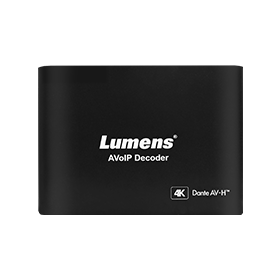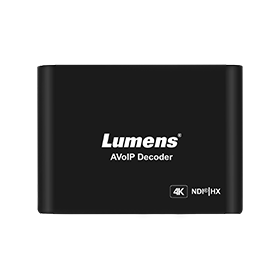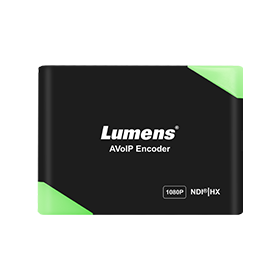IP Video Formats: A Guide for Video Conferencing and UC
Written by Kieron Seth, Product Marketing Director at Lumens
July 14, 2025 6196
- HDBaseT and Video Conferencing
- IP Video and Video Conferencing
- Video Streaming Formats
- Quality First: 4K in Video Conferencing?
- Latency
- Bandwidth
- Ensuring Video Stream Security
- Virtually Adding Video Streams to a Conference Call
- The Hardware Alternative
- Key Products
IP Video producers and broadcasters know all about media streaming formats. It's a fundamental part of setting up a camera, sharing media across creative teams and transmitting video to audiences around the world. But what about AV teams working with video conferencing technology?
Video conferencing is dependent on connecting cameras and audio equipment to the room PC or BYOD laptop. Increasingly, these connections are made over IP. Let's start by considering the camera side.
Previously, professional-quality video conference cameras connected using USB, HDMI, DVI, co-ax and SDI. Consequently, streaming video formats were not a concern. These fantastic technologies were reliable, with low latency and support for high quality transmission. However, the video conferencing world is moving away from these cables owing to the complexity of system management, the cost of wiring and the restriction on cable lengths. With AV transitioning to an IT-centric world (and its promise of central control, one cable connectivity and instant scalability), Ethernet CAT cable is now dominating the market.
▶ HDBaseT and Video Conferencing
HDBaseT runs on CAT-5 or CAT-6 cable. It delivers video, audio, power and control over a single cable. On the surface, it’s the ideal candidate for video conference system installers. As a video format, however, it has limitations. It is only designed for direct connections between a transmitter and a receiver; as it does not use Layer 2 frames or MAC addresses, it is incompatible with most network switches to forward data. To distribute HDBaseT signals to multiple locations, there's a requirement for new Ethernet cabling and a dedicated HDBaseT matrix switch, which acts as a central point for routing the signals. As a result, despite its high quality, low delay and ease of use, facility-wide HDBaseT does not offer the flexibility that many integrators are searching for.
▶ IP Video and Video Conferencing
IP formats have significant advantages over both traditional wiring and HDBaseT. These include:
- Use of inexpensive CAT cabling
- Use of the existing 1G and 10G LAN
- Instant scalability of the network
- Software-based routing
- Format agnostic infrastructure
- Centralized security and administration
- Network-based powering
- Consolidation of IT, AV and UC
▶ Video Streaming Formats
Because of these inherent strengths, the march towards IP seems unstoppable. The next question is which format to choose for transporting video signals over the network. There are numerous available options, and we hope that the following makes it easier to reach a decision that's right for each installation.
At the time of writing (midway thru 2025), the dominant streaming formats are as follows:
| Format | Codec | Hardware Support |
| Dante AV Ultra | Colibri | FPGA |
| Dante AV-A | AGIC3, Advanced Graphic and Image Codec Gen3 | ASPEED SOC |
| Dante AV-H | H.264/HEVC | SOC |
| NDI Full Bandwidth | SpeedHQ | FPGA / SOC |
| NDI HX2 | H.264/HEVC | SOC |
| NDI HX3 | H.264/HEVC | SOC |
| RTSP | H.264/HEVC | SOC |
| SMPTE 2110-20 | Uncompressed | FPGA |
| SMPTE 2110-22 | JPEG XS | FPGA |
Typically, codecs that are H.264/HEVC-based are more cost-effective to implement and can be processed using off-the-shelf hardware and software. Formats that use proprietary codecs or a high-performance FPGA have distinct quality and latency advantages, but can be challenging, financially and technically.
Cameras that generate RTSP, Dante AV-H, NDI HX and NDI full bandwidth video streams are widely available. These models transmit over local area networks for decoding to HDMI and USB. More complex streaming formats may need multiple levels of encoding and decoding to make them compatible with video conferencing systems.
▶ Quality First: 4K in Video Conferencing?
As you can see from the below, all formats are capable of transporting video that can match or outstrip the capability of many television stations.
| Format | Max Resolution | Color Space Support |
| Dante AV Ultra | Up to 4K|60fps | 4:4:4 |
| Dante AV-A | Up to 4K|60fps | 4:4:4 |
| Dante AV-H | Up to 4K|60fps | 4:2:0 |
| NDI Full Bandwidth | Up to 4K|60fps | 4:2:2 or 4:4:4 |
| NDI HX2 | Up to 4K|60fps | 4:2:0 |
| NDI HX3 | Up to 4K|60fps | 4:2:0 |
| RTSP | Up to 4K|60fps | 4:2:0 |
| SMPTE 2110-20 | Up to 4K|120fps | 4:4:4 |
| SMPTE 2110-22 | Up to 4K|120fps | 4:2:2 or 4:4:4 |
Currently, very few conference systems support 4K video. Over the next decade, it is likely that the number of platforms supporting UltraHD will increase, but overwhelmingly HD is considered more than acceptable for today’s communicators. It is also worth noting that resolution is not always the most important factor when it comes to perceived quality: it’s first worth weighing up how a camera copes with low lighting, how good the lens is and how accurate the focus is, for example. An HD PTZ model like Lumens VC-R31 will outperform many consumer 4K webcams, while delivering far greater versatility.
▶ Latency
At live music concerts, conferences and presentations, venue screens need to display the performers and presenters with minimal delay (3-6 frames is the usual rule of thumb). In video conferencing, this is less of an issue: the audio and video need to be synchronized and transmitted in a way that enables normal human conversation. A delay of under half a second is usually acceptable. With this in mind, all the formats we are considering here are appropriate for video conferencing from a latency perspective. To minimize delay on the network, we recommend users not to connect cameras via WiFi.
| Format | Latency |
| Dante AV Ultra | Extremely Low |
| Dante AV-A | Low |
| Dante AV-H | Low |
| NDI Full Bandwidth | Low |
| NDI HX2 | Moderate |
| NDI HX3 | Low |
| RTSP | Moderate |
| SMPTE 2110-20 | Imperceptible |
| SMPTE 2110-22 | Imperceptible |
▶ Bandwidth
What may have more impact than the inherent latency of a format is its bandwidth requirement. Bandwidth is finite. Typical local area networks operate on 1Gb or 10Gb Ethernet, with some making the next step to 25/40Gb networking. The speed of, and the load on, the LAN are critical factors to consider before selecting a streaming format. In an ideal world, a high bandwidth, very low latency format would be an easy choice. However, assessing competing demands on a network and the growth of video conferencing across organizations, it is often wiser to select cameras that operate at low or very low bandwidths.
| Format | Bandwidth Usage |
| Dante AV-H | Very Low (under 30Mb/s) |
| NDI HX2 | Very Low (under 30Mb/s) |
| NDI HX3 | Low (under 90Mb/s) |
| RTSP | Very Low (under 30Mb/s) |
| Dante AV Ultra | Medium (under 1Gb/s) |
| Dante AV-A | Medium (under 1Gb/s) |
| NDI Full Bandwidth | Medium (under 1Gb/s) |
| SMPTE 2110-22 | Very High (over 1Gb/s) |
| SMPTE 2110-20 | Extreme (over 10Gb/s) |
Again, it is always sensible to consider that platforms such as Teams and Zoom will reduce the frame rate, resolution and bitrate to accommodate the network conditions experienced by remote users, who may be connecting using slow broadband or cellular connections. In other words, a camera producing very high bitrate video streams may not translate into a wholly superior experience for dial-in guests.
▶ Ensuring Video Stream Security
A video or USB cable that runs from a camera to a computer is inherently secure. Transmitting over a local area network, however, introduces the potential for serious data breaches. Imagine a discussion between health professionals about the treatment plan for a patient, conversations between legal and financial teams about a forthcoming acquisition or the performance review of a student; each scenario entails highly sensitive and privileged information that must be restricted to specific individuals or teams.
With some formats, this is difficult to achieve. Secure authentication, VLANS (virtual LANS), port isolation and other network tools can provide a level of security. The gold standard is AES256 encryption, which is practically unbreakable.
| Format | Security |
| Dante AV Ultra | AES256 encryption |
| Dante AV-A | AES256 encryption |
| Dante AV-H | AES256 encryption |
| NDI Full Bandwidth | - |
| NDI HX2 | AES256 encryption (with NDI Bridge) |
| NDI HX3 | AES256 encryption (with NDI Bridge) |
| RTSP | Secure Authentication |
| SMPTE 2110-20 | - |
| SMPTE 2110-22 | - |
While Dante formats offer AES256 encryption as standards, NDI HX can also be encrypted with the use of NDI Bridging technology which requires the installation of a dedicated server.
▶ Virtually Adding Video Streams to a Conference Call
Clearly each format has particular strengths that make it well suited to particular roles within AV. The final question is how to add the IP video stream to the conference platform (usually a PC, Mac or laptop).
With RTSP streams, the user can connect the PC to the network and install a virtual USB driver. This allows the computer to discover the relevant RTSP stream and add it as a webcam. Lumens Virtual Camera 2.0 provides audio and video synchronization and high quality 4K and HD pictures.
The same is the case with NDI HX. NDI Tools includes NDI Webcam Input which also works directly with all major conferencing platforms.
▶ The Hardware Alternative
Virtual USB drivers are very common, but they do have downsides. They require powerful processors and require installation and management on every computer that wants to use an RTSP or NDI camera as a webcam.
Lumens' OIP Bridge devices are a user-friendly alternative to virtual drivers. As network devices, they convert NDI HX, RTSP and Dante AV-H video streams to USB-C; plugging the cable into any computer instantly adds a webcam with no need for system re-configuration or drivers. Better still, it can also convert IP audio, including Dante Audio on the Dante AV-H version. For the end user, this means one USB-C delivers video and audio, with no need for an audio adapter, or dedicated audio cables.
▶ Key Products
Click here Back to Top ↑




